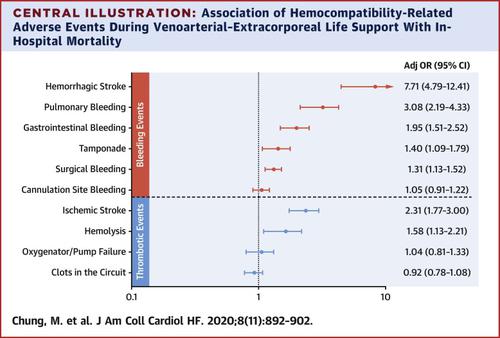JACC: Heart Failure ( IF 13.0 ) Pub Date : 2020-10-26 , DOI: 10.1016/j.jchf.2020.09.004 Mabel Chung 1 , Fausto R Cabezas 2 , Jose I Nunez 2 , Kevin F Kennedy 3 , Katelyn Rick 2 , Peter Rycus 4 , Mandeep R Mehra 5 , A Reshad Garan 2 , Robb D Kociol 2 , E Wilson Grandin 6

|
Objectives
This study sought to determine the frequency, incidence rates over time, association with mortality, and potential risk factors for hemocompatibility-related adverse events (HRAEs) occurring during venoarterial-extracorporeal life support (VA-ECLS).
Background
HRAEs are common complications of VA-ECLS. Studies examining relevant clinical predictors and the association of HRAEs with survival are limited by small sample size and single-center setting.
Methods
We queried adult patients supported with VA-ECLS from 2010 to 2017 in the Extracorporeal Life Support Organization database to assess the impact of HRAEs on in-hospital mortality.
Results
Among 11,984 adults meeting study inclusion, 8,457 HRAEs occurred; 62.1% were bleeding events. The HRAE rate decreased significantly over the study period (p trend <0.001), but rates of medical bleeding and ischemic stroke remained stable. HRAEs had a cumulative association with mortality in adjusted analysis: 1 event, odds ratio (OR) of 1.43; 2 events, OR of 1.86; ≥3 events, OR of 3.27 (p < 0.001 for all). HRAEs most strongly associated with mortality were medical bleeding, including intracranial (OR: 7.71), pulmonary (OR: 3.08), and gastrointestinal (OR: 1.95) hemorrhage and ischemic stroke (OR: 2.31); p < 0.001 for all. Risk factors included the following: for bleeding: older age, lower pH, and female sex; for thrombosis: younger age, male sex, Asian race, and non-polymethylpentene oxygenator; and for both: time on ECLS, central cannulation, and renal failure.
Conclusions
Although decreasing, HRAEs remain common during VA-ECLS and have a cumulative association with survival. Bleeding events are twice as common as thrombotic events, with a hierarchy of HRAEs influencing survival. Differential risk factors for bleeding and thrombotic complications exist and raise the possibility of a tailored approach to ECLS management.
中文翻译:

静脉动脉体外生命支持的血液相容性相关不良事件和存活率
目标
本研究旨在确定静脉动脉-体外生命支持 (VA-ECLS) 期间发生的血液相容性相关不良事件 (HRAE) 的频率、随时间的发生率、与死亡率的关联以及潜在危险因素。
背景
HRAE 是 VA-ECLS 的常见并发症。检查相关临床预测因子和 HRAE 与生存率关联的研究受到样本量小和单中心设置的限制。
方法
我们在体外生命支持组织数据库中查询了 2010 年至 2017 年接受 VA-ECLS 支持的成年患者,以评估 HRAE 对院内死亡率的影响。
结果
在符合研究纳入的 11,984 名成年人中,发生了 8,457 次 HRAE;62.1% 是出血事件。HRAE 率在研究期间显着下降(p 趋势 <0.001),但内科出血和缺血性中风的发生率保持稳定。在调整后的分析中,HRAE 与死亡率具有累积关联:1 个事件,优势比 (OR) 为 1.43;2 个事件,OR 为 1.86;≥3 个事件,OR 为 3.27(所有 p < 0.001)。与死亡率最相关的 HRAE 是医疗出血,包括颅内 (OR: 7.71)、肺 (OR: 3.08) 和胃肠道 (OR: 1.95) 出血和缺血性卒中 (OR: 2.31);p < 0.001 所有。危险因素包括: 出血:年龄较大、pH 值较低和女性;血栓形成:年轻、男性、亚洲人种、非聚甲基戊烯氧合器;以及两者:在 ECLS 上的时间,
结论
尽管有所减少,但在 VA-ECLS 期间 HRAE 仍然很常见,并且与生存率具有累积关联。出血事件是血栓事件的两倍,HRAE 的等级影响生存。存在出血和血栓并发症的不同危险因素,并提高了针对 ECLS 管理量身定制方法的可能性。


























 京公网安备 11010802027423号
京公网安备 11010802027423号